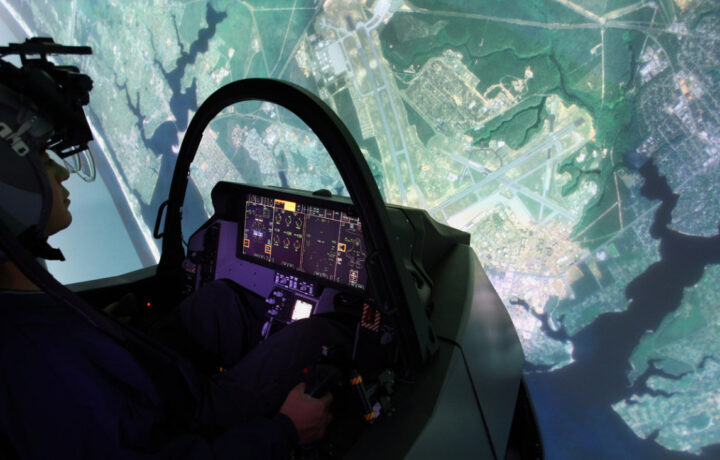The Lockheed Martin F-35 Lightning II has been touted as one of the most capable combat aircraft in the world, but the fifth-generation stealth fighter has also earned its share of critics – who often cite the acquisition and sustainment costs of the aircraft. In addition, the Government Accountability Office (GAO) last month issued a report that found the U.S. military was scaling back flight hours with the multi-role fighter due to its high operating costs.
The F-35 Joint Program Office has fired back that the aircraft is getting more expensive to operate, but at the same time, all the hours that pilots spend in the cockpit take a toll on any airplane. Even as pilots do need the actual flight hours, simulators are increasingly playing a role in training. These allow aviators to prepare for emergencies and other incidents by repeating certain scenarios – which can be reset quickly.
Much More Than a “Flight Simulator”
Considered the most advanced, high-fidelity flight simulator in widespread use, the F-35 Full Mission Simulator (FMS) flight simulation and training system is employed by the U.S. Air Force, U.S. Navy, and United States Marine Corps as well as those from international F-35 partners. The FMS was first introduced in 2017 and updated in 2021.
It features actual aircraft components including the stick and throttle that pilots would use on the actual aircraft, while the FMS also replicates the software, sensors, and even weapons of the real Lightning II.
More than 2,400 pilots have been schooled via the FMS, according to Lockheed.
Geospatial Intelligence
The core of the FMS is the lifelike visuals and environments that include precise, geospatial intelligence provided by Westminster, CO-based Maxar Intelligence. Its 2D and 3D products serve as the geospatial foundation for the FMS, providing a realistic representation of real-world operating environments to enhance pilot training and mission rehearsal.
This week, the company announced a long-term agreement with Lockheed to standardize pricing, licensing, and requirements for several Maxar products, including Dynamic basemaps and Precision3D, enabling F-35 customers to begin training and mission preparedness operations faster, the company announced.
“Maxar Intelligence is excited to expand on our long-standing partnership with Lockheed Martin and further improve the F-35 Full Mission Simulator experience, which represents an industry gold standard for immersive training and mission readiness support,” explained Susanne Hake, general manager for the U.S. Government sector at Maxar Intelligence.
Hake added that Maxar’s geospatial products, particularly Precision3D, are critical to the success of this system. The data suit provides highly accurate and detailed 3D models of Earth with 50-centimeter resolution and absolute accuracy of 3 meters in all dimensions. That accuracy is achieved without ground control and is consistent on all surfaces and terrain types, including building facades, the company stated.
Moreover, Precision3D can provide those using the FMS with a precise, true representation of Earth that reflects the terrain in all dimensions, while also providing an accurate foundation for additional data sources through Precision3D Registration (P3DR) georegistration.
“[This enables] the highly accurate, precise simulated real-world environments that are brought to life in the FMS, creating an immersive experience that helps improve pilot safety and enhance mission success,” added Hake.
In addition to Precision3D, the agreement with Lockheed Martin includes the Maxar Dynamic imagery basemaps, which utilize the latest mosaicking technology, color balancing, and image processing to produce high-resolution, high-accuracy image layers.
The Military And Simulations
The United States military increasingly relies on simulations, including those that employ virtual reality (VR) and augmented reality (AR) as training aids for years. New advances in these technologies could further spur opportunities for the developers of military simulations, which would allow for interoperable training modules, web-based platforms, and cloud computing that would enable U.S. military personnel to train with NATO allies without having to leave their home bases.
The United States Navy went full steam ahead with VR in June 2021, when it unveiled its virtual combat training facilities in San Diego and Pearl Harbor. It duplicated the shipboard undersea warfare (USW) combat system used in its DDG 51 Arleigh Burke-class destroyers and CG 47 Ticonderoga-class cruisers. Integrated with the AEGIS combat system, the simulation provides a full range of undersea warfare functions.
Earlier this year, the United States Space Force’s Space Systems Command announced that tech giant Microsoft would develop the “Immersive Intelligent Environment” augmented reality space simulation. Dubbed I3E, the simulation will be powered by Microsoft’s HoloLens headset and feature a real-time display of orbital objects, while it will allow Space Force guardians to interact with them in an accurately scaled space environment. The I3E will enable Space Force guardians to plug and play new and emerging space capabilities into the environment to understand better their interactions and impacts on the overall space architecture.




